Lebanon: property transactions continue to fall
Property prices still remain surprisingly resilient in Lebanon, though some developers are offering about 5% to 10% discounts to homebuyers.
However demand, especially from foreigners, has fallen sharply due to domestic political bickering and regional unrest.
“It has been more than a year since Gulf investors and most expats exited the market,” said John Eid, the owner of Locus Real Estate Consulting. "Those who are still buying property today are citizens who take subsidized loans for very small apartments." In the first half of 2013, the number of property sales to foreigners fell by 8.6% from the same period last year, after declines of 8.9% in 2012 and 20.3% in 2011.
About 72% of residential projects in Beirut completed in 2012 (about 217 apartments with a total market value of US$400 million) remain unsold as of June 2013, according to Ramco Real Estate Advisers.
New housing loans are falling. Construction activity is also down.

Because prices remain high, homebuyers have been moving out from Beirut, the capital, to look for cheaper housing. During the first six months of 2013, Beirut accounted for just about 25.2% of the total value of property transactions, down from about 37.2% in 2007. Less expensive nearby areas, such as Baabda, Metn, and Kesrouan accounted for 56% of the total sales in H1 2013, up from 47% in 2007.
The Lebanese property market has experienced strong house price rises in recent years:
- In 2008, average property sales prices rose by 26.8% y-o-y (14.5% in real terms)
- In 2009, property prices rose by about 8.4% y-o-y (7.1% in real terms)
- In 2010, average property sales prices increased by 20.2% y-o-y (15.1% in real terms)
- In 2011, the average value per property sale rose by 5.9% y-o-y (0.9% in real terms)
- In 2012, property prices remained steady from the previous year
In the first half of 2013, the total value of real estate transactions dropped 8.2% y-o-y to US$3.81 billion, according to the Bank Audi. In 2012, the value of transactions was almost static.
The average sales price of residential properties in Lebanon ranges between US$3,800 and US$4,500 per square metre (sq. m.), according to Ramco Real Estate Advisers.
From January to May 2013, the total area of new construction permits, a leading indicator of the condition of the sector, plunged 14.2% to 5.2 million square meters (sq. m.) from the same period last year, after experiencing annual drops of 11.7% in 2012 and 6.8% in 2011, based on figures released by the Order of Engineers of Beirut and Tripoli. Likewise, the total number of construction permits for housing units dropped 12.2% y-o-y to 22,108 in 2012.
Some property developers have modified their existing projects to adapt to the new demand for affordable small-sized flats. In 2012, about 52% of new residential permits across all areas in Lebanon (except the North) were apartments of up to 150 square meters (sq. m.), up from around 44% in 2010.
New housing loans dropped by 12.5% to US$1.29 billion in 2012 from the previous year. However, the total housing loans portfolio of banks in Lebanon were up by 21.5% to US$7.27 billion in 2012 from the previous year, according to Bank Audi’s Group Research Department. When compared to 2007, total housing loans actually skyrocketed by about 450% in 2012.
In an effort to boost the property market, Banque du Liban, Lebanon’s central bank, unveiled in January 2013 that it would inject LBP 2.2 trillion (US$1.46 billion) in credit facilities to commercial banks at a 1% interest rate until end-2013 aimed at subsidizing housing loans.
Property sales transactions in Lebanon are expected to continue falling in the coming months while house prices are projected to remain flat over the same period, according to the Bank Audi.
Economic performance remains subdued amidst regional political unrest

By mid-2012, the Syrian conflict which began in March 2011 had spilled over into the country in deadly clashes between Sunni Muslims and Alawites in Tripoli and Beirut. This raised fears that Lebanon’s already fragile political truce could collapse again into a sectarian strife. It is estimated that there are about 700,000 Syrian refugees in Lebanon.
Then in March 2013, Najib Mikati’s government resigned amidst political tensions over upcoming elections. General elections, due in June, were put off until November 2014 due to security concerns over the conflict in Syria.
Economic growth has slowed sharply with annual GDP growth rates of 1.5% in both 2011 and 2012, the slowest growth rates since 2006, according to Banque du Liban.
Lebanon's religious communities maintain a watchful equilibrium. To maintain the balance of power between religious groups, the president must be a Maronite Catholic Christian, the prime minister a Sunni Muslim, the deputy prime minister an Orthodox Christian and the speaker of parliament a Shi’a Muslim. The 128 parliamentary seats are equally divided between Christian and Muslims.
The country’s economy and populace were ravaged during the Lebanese Civil War from 1975 to 1990. From the 1990s to the early-2000s, there was an uneasy calm, with external forces and militant groups occupying different parts of the country.
In 2005, former Prime Minister Rafik Hariri was assassinated. Then in July 2006, the Israel-Hezbollah War erupted, which caused large-scale damage to Beirut, undoing much of the good work done in the post-Civil War reconstruction programme. In May 2007, the violent Nahr al-Bared conflict, the most severe internal fighting in almost two decades, exploded and ravaged some parts of the country.
Finally in May 2008, the Doha Accord marked the end of an 18-month long political crisis. Local political and security conditions improved considerably, with the Lebanese government determined to pursue reforms focused on achieving economic revival, sustainable growth and political stability.
The political stability in the country helped the economy grow strongly, with an average annual GDP growth rate of 8.25% from 2007 to 2010.
However political unrest, both domestic and regional, is now affecting economic growth. Domestic political tensions brought down the government of Prime Minister Saad al-Hariri in January 2011. He was succeeded by Najib Mikati, whose cabinet is dominated by Hezbollah and its allies. But Mikati’s government is now criticized for its inability to solve the country’s economic and social problems.
In June 2011, the UN issued arrest warrants for four members of Hezbollah in the murder of former PM Rafik Hariri. Hezbollah was uncooperative and refused to allow any suspects to be arrested. Tensions have been exacerbated by the ongoing Arab Spring since December 2010.
The Lebanese economy contracted by 0.3% in the second quarter of 2013, according to Byblos Bank. Real GDP growth is expected at about 1.2% in 2013, according to the Institute of International Finance.
Land price variations
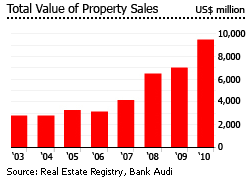
In Beirut’s prime areas, land prices currently ranged from LBP3 million (US$2,000) to LBP7.6 million (US$5,000) per square meter (sq. m.) of built-up area (BUA), according to Ramco Real Estate Advisers.
- The Central Business District (CBD) has the most expensive land in Beirut. Land prices ranged from LBP5.3 million (US$3,500) to LBP7.6 million (US$5,000) per sq. m.
- In Hamra, one of Beirut’s main economic and diplomatic hubs, land prices ranged between LBP2.73 million (US$1,800) and LBP3.33 million (US$2,200) per sq. m.
- In Furn el Hayek, which is in high demand from the local social elite, land prices vary from LBP2.73 million (US$1,800) and LBP3.03 million (US$2,000) per sq. m.
On the other hand, in underdeveloped peripheral areas, land prices vary between LBP1.2 million (US$800) and LBP2.3 million (US$1,500) per sq. m. of BUA.
- In Jnah, an underdeveloped area in the capital, land prices ranged between LBP1.8 million (US$1,200) to LBP2.3 million (US$1,500) per sq. m.
- In Comiche El Nahr, land prices ranged between LBP1.2 million (US$800) to LBP2.1 million (US$1,400) per sq. m.
Property sales falling
In the year to end-Q3 2011, the total number of property sales in Lebanon fell by 16.5% to 57,976 units from the same period last year, according to Bank Audi. The total number of property sales rose by 13% y-o-y in 2010 but dropped by 18% in 2009.
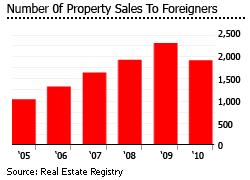
Likewise, the total value of property sales plunged by 13.4% to LBP9.14 trillion (US$6.03 billion) over the year to Q3 2011, according to data released by the Real Estate Registry. From 2005 to 2010, total property sales value increased by an average of 23.5% per year.
The regional political unrest is negatively affecting property investments by foreigners and other Arab nationals. As of May 2011, property sales to foreigners plunged by 32.1% from the same period of the previous year, according to the Real Estate Registry. In 2010, the number of property sales to foreigners dropped by 17% y-o-y, after an average annual growth of 22% from 2006 to 2009.
As of October 2011, foreign homebuyers represent just about 2.02% of sales transactions in Lebanon, down from 2.04% in 2010 and 2.53% in 2009.
Construction activity declining
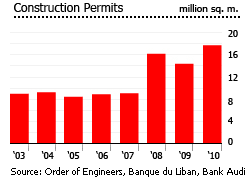
New construction permits, an indicator of construction activity and future supply, are now falling after having increased by an average of 16.4% annually from 2005 to 2010.
As of November 2011, newly issued construction permits were 6.2% down to 14.72 million sq. m. compared to the same period in the previous year, according to the Order of Engineers in Beirut and Tripoli.
However, cement deliveries, also a gauge of the state of the construction sector, increased 7.7% to 4.16 million tons during the year to end-Q3 2011.
Some of the major residential developments in Lebanon:
BeitMisk
BeitMisk is a huge $800 million residential community project in the mountainous Northern Metn region, covering more than 655,000 sq. m., and expected to house around 15,000 residents. Announced in mid-2009, BeitMisk offers apartment units, villas and penthouses to homebuyers. It also offers a country club, gardens, recreational areas, and retail stores.
Beirut
The Beirut Towers is a US$125 million luxury residential development in Beirut launched by Plus Properties, a Dubai-based developer. Still under construction, it consists of two 23-storey towers, named Verdun and Ashrafieh—two of the most prestigious residential neighborhoods in the city. The two towers offer studio, one and two-bedroom apartments on single or duplex floors.
Venus Towers
This US$500 million residential development was launched last September 2009 by Venus Real Estate Development Co. It stretches over 7,510 metres in Marina, Solidere in Beirut. The development is surrounded by 3,500 sq. m of gardens, jogging tracks and playgrounds.
Venus Towers has 3 luxurious residential buildings—Bloc A-30-storey; Bloc B-26-storey; and Bloc C-20-storey. Apartments range from 250 sq. m to 650 sq. m. Amenities include a swimming pool, gymnasium, guest parking spaces, a commercial area and a security.
Marina Towers
The Marina Towers, completed in 2007, is a residential complex near the Beirut Marina. The development consists of the Marina Tower, Marina Court, and Marina Garden. The Marina Tower is the highest among the three buildings, at 150-m height built on over 7,000 sq. m land. On the other hand, the Marina Garden, surrounded by over 3,000 sq. m gardens, and the Marina Court, offers relatively smaller apartment units.
Sama Beirut
Launched in August 2009 by Antonios Projects, Sama Beirut is a 50-storey mixed use project located in Ashrafieh, near downtown Beirut, set to be fully-operational by 2014.
Its 200-m skyscraper, set to become the tallest building in the country, will have residential, commercial and retail space. It offers residential apartments, with sizes ranging from 300 sq. m to 1,500 sq. m. In addition, the tower will also feature six commercial shops and office spaces.
Platinum Towers
Platinum Towers, at 153-metres, is currently Lebanon’s tallest residential building. The US$200 million building, completed in 2008, is in the heart of Beirut’s dynamic central district, along the Beirut Marina. Platinum Towers is only a few minutes away from the Beirut International Airport.
Mortgage market expanding
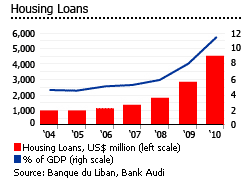
In Lebanon, buyers have traditionally paid cash, or benefited from pre-selling schemes. Homebuyers purchase an apartment unit during the construction phase, put a down payment and make monthly installments until the project is completed.
Housing loans have traditionally only been available to the developers of new properties. Yet today, several banks have begun offering mortgage loans directly to homebuyers. The Lebanese mortgage market grew to 11.5% of GDP in 2010, from an average of 4.9% from 2004 to 2007.
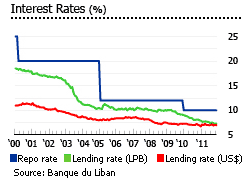
Outstanding housing loans soared 61% to LBP6.83 trillion (US$4.51 billion) in 2010 from a year earlier, according to the Banque du Liban. Then in March 2011, total outstanding housing loans rose again by 7% q-o-q to LBP7.27 trillion (US$4.8 billion).
The repo rate is currently at 10%, unchanged since December 2009.
Interest rates for housing loans are usually tied to the US prime rate or LIBOR, with a fixed percentage added. The loan-to-value (LTV) ratio ranges from 50% to 85% of the appraised value or actual purchase price of the property, whichever is lower. The term period is usually from 20 to 30 years. Lebanese banks require both life and house insurance from loan applicants.
The biggest risk - falling rental yields
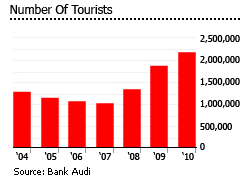
Gross rental yields in Beirut have again dropped in 2011. Gross rental yields on Beirut apartments now range from 2.7% to 3.5%, very significantly down from an average of 10% to 11% six years ago.
In October 2011, the average monthly rents in Beirut ranged from LBP2.84 million (US$1,872) for 150 sq. m. apartments, to LBP8.74 million (US$5,769) for 450 sq. m. apartments, according to the Global Property Guide’s research.
Average rents for the market as a whole are lowered by the survival of many pre-1992 contracts, creating a class of sitting tenants paying low rents, who cannot be evicted except at great cost (see Lebanon’s Landlord and Tenant Law). However this law does not affect post-1992 contracts, which are equally balanced between landlord and tenant. (The Global Property Guide’s research only covers current offers for sale and offers to rent, not pre-existing contracts).
In Beirut, the average occupancy rate is about 60%, according to Ramco Real Estate Advisers.